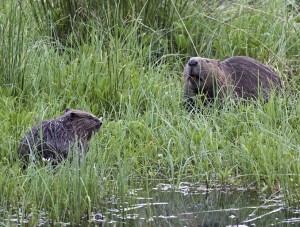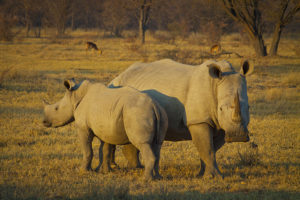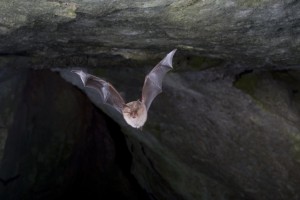Whole Ecosystems Shifting North
Entire ecosystems are shifting north in the Great Plains of North America, according to analysis of 50 years worth of data on bird distributions. These findings could aid the development of an early-warning system for land managers.
 Image: By NASA/ GSFC/ NOAA/ USGS [Public domain]
Image: By NASA/ GSFC/ NOAA/ USGS [Public domain] In the present era of rapid global change, development of early warnings of ecological regime shifts is a major focus in ecology. Identifying and tracking shifts in spatial regimes is a new approach with potential to enhance understanding of ecological responses to global change. In the Great Plains, whole ecosystems are shifting dramatically north, a phenomenon likely linked to human influences such as climate change, says new University of Nebraska-Lincoln research that analysed nearly 50 years’ worth of data on bird distributions.
The northernmost ecosystem boundary shifted more than 365 miles north, with the southernmost boundary moving about 160 miles from the 1970 baseline.
The findings could inform the development of an early-warning system that would give land managers decades to prepare for ecosystem shift or collapse, allowing them to accommodate or foster the change rather than simply reacting, the researchers said.
Early warning, long the siren song for extreme weather events such as tornadoes, is likewise an emerging goal in ecology. Ecologists long thought that ecosystems respond to external pressures, climate changes, invasive species, for example, in idiosyncratic, largely unpredictable ways. But the team’s new study, published last month in the journal Nature Climate Change, managed to quantify the spatial component of that change for the first time. In doing so, it suggests that ecological responses are much more ordered and predictable than previously thought.
Caleb Roberts, lead author and postdoctoral researcher at Nebraska, said: “If we can work toward prevention (of changes), we’re going to save ourselves so much money and time. We won’t have to worry about specific endangered species, perhaps, because we will be protecting the system they require.”
To arrive at their conclusions, the researchers analysed 46 years’ worth of avian data collected for the North American Breeding Bird Survey, a cooperative effort between the U.S. Geological Survey’s Patuxent Wildlife Research Center and Environment Canada’s Canadian Wildlife Service to monitor the status and trends of North American bird populations. Data are collected by thousands of dedicated participants along thousands of randomly established roadside routes throughout the continent. The survey used for the study included more than 400 bird species found within a 250-mile-wide transect stretching from Texas to North Dakota.
The team then separated bird species into groups based on their body masses and searched for gaps in the distribution of the groups. Those gaps effectively act like the DNA signature of an ecosystem, said co-author Craig Allen, allowing the team to identify where one ecosystem ends and another begins.
By analysing the geographic movement of the distinct body-mass signatures over the 46-year period, the team managed to measure how much and how fast each ecosystem shifted north.
“All (these breaks) are saying is that there are a lot of animals with the small body size; then there’s a gap with nothing in this middle body size; then you have another group and another group. And since these reflect the domains of scale in an ecosystem, it’s like a signature – the DNA – of a given ecosystem,” says Allen, who is director of the university’s Center for Resilience in Working Agricultural Landscapes.
Over their study area, and over time, the researchers identified three distinct ecosystem boundaries, with a fourth – and thus a fourth ecosystem regime – appearing in the final decade.
The fact that the northernmost boundary shifted more than its southernmost counterpart reflects a well-documented phenomenon known as Arctic amplification, suggesting that climate change is at play, the researchers said. But the movement also aligns with other global change drivers that include wildfire trends; the invasion of woody plants such as eastern red cedar trees; energy development; agricultural land conversion; and urbanisation.
Allen explains: “Like most things in ecology, (these shifts) likely have multiple causations. And I think it’s fairly intractable to try to separate, say, tree invasion from climate change, because it has to do with fire but also with changing climate. All of these things are highly related.”
Grasslands are the most endangered ecosystem in the world, Roberts said, partially due to woody-plant encroachment. That encroachment, he said, is something people can work to control by increasing burning, increasing tree removal and decreasing planting: “Those are all things we can do and use the early warning to say, ‘We’re coming to the edge of this grassland’s resilience. It’s about to collapse, especially in our area. What can we do to stop that?’ That’s the kind of power this tool would have. You don’t have to wait until it gets to you. You can see it coming and act pre-emptively.”
When land managers do wait until the problem arrives at their backdoor, Allen said, it’s often too late to alter the outcome. Given that urgency, the researchers plan to expand the range of their ecosystem analysis both east and west, potentially picking up forestlands and mountain ranges, while further clarifying how neighbouring ecosystems move in relation to one another and in relation to global drivers.
The researchers say that, eventually, they intend to develop tools usable by land managers and conservationists ranging from private industry to the military.
“We are working closely with a long list of partners to understand how to navigate these types of transitions and increase the performance of conservation investments,” said Dirac Twidwell, associate professor of agronomy and horticulture. “Large-scale transitions should not be underestimated. Restoring what has been lost has proven extraordinarily difficult when the challenge spans large geographic regions.”





Sorry, comments are closed on this post